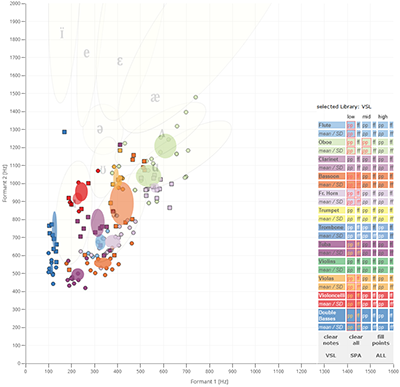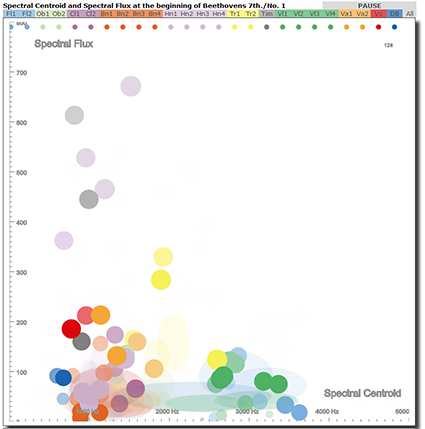|
21st
Quinquennial IMS Congress, Athen, 21.-26. August 2022 Orchestral
Manoeuvres in the Light Formants are pitch-independent, fixed maxima in the spectrum of a sound that characteristically shape the timbre of an instrument or voice. For
example, instruments with a maximum between 300 and 500 Hz
sound like "o" (e.g. bassoon or horn). With the help of two axes for the first and second formant, one can draw up a formant map in which the musical instruments of the orchestra can be placed on characteristic positions. this holds especially for the low and middle registers. Timbres
with similar formant positions usually sound similar
and blend well together when played simultaneously. In the Formant Map 2.0, any instrument combinations can be tried out in three registers and two dynamic levels each. |
Dynamic
Timbre Maps in Comparison
on the
example of Beethoven's 7th symphony, 1st movement
Select
one of the three fields below and compare the dynamic behavior
of the instrumental timbres and their descriptors in "the wild".
You can set up any instrumental combination using the colored buttons
at the top of the of the respective Dynamic Timbre Map screen.
The closer the timbres are to each other in the respective Dynamic Timbre
Map,
the more similar they should sound.
Attention:
the dynamic timbre fields need about 30 seconds until they are fully loaded.
But it's worth the wait...
Reverberation
free single tracks of the musical instruments from:
Pätynen, J., Pulkki, V., and Lokki, T., "Anechoic recording
system for symphony orchestra," Acta Acustica united with Acustica,
vol. 94, nr. 6, pp. 856-865
|
Further interactive timbre representations: Timbre Spaces Formant Maps
Current libraries/programs for formant calculation |



